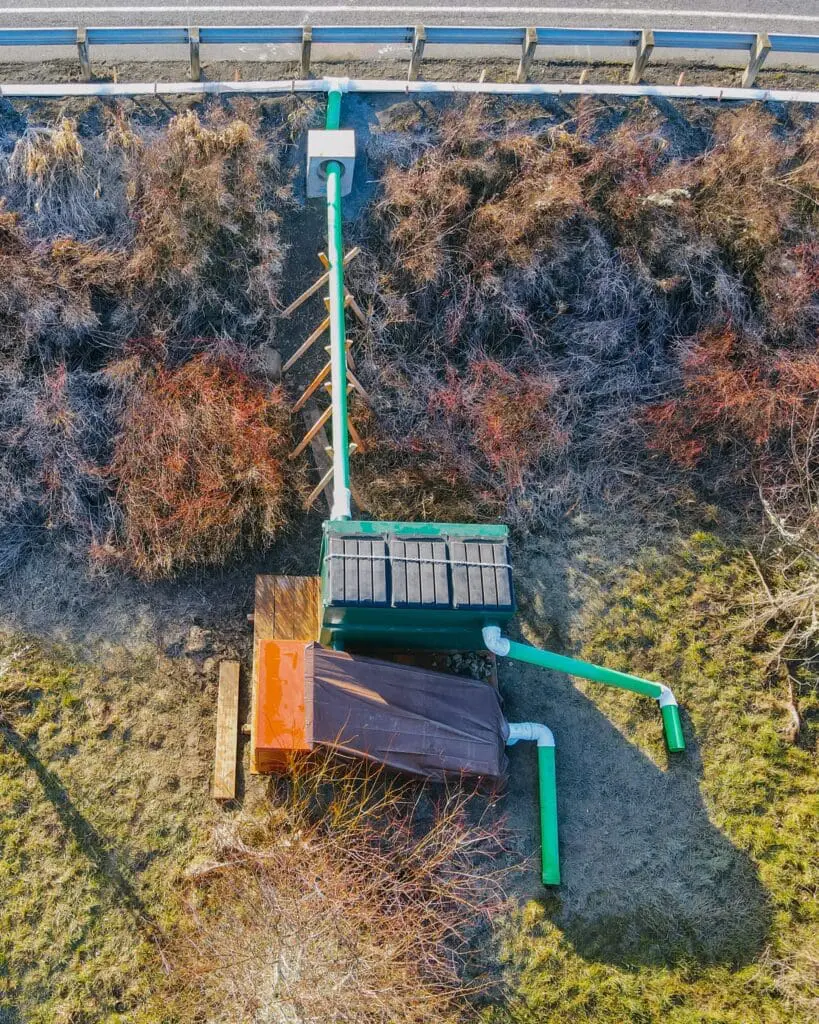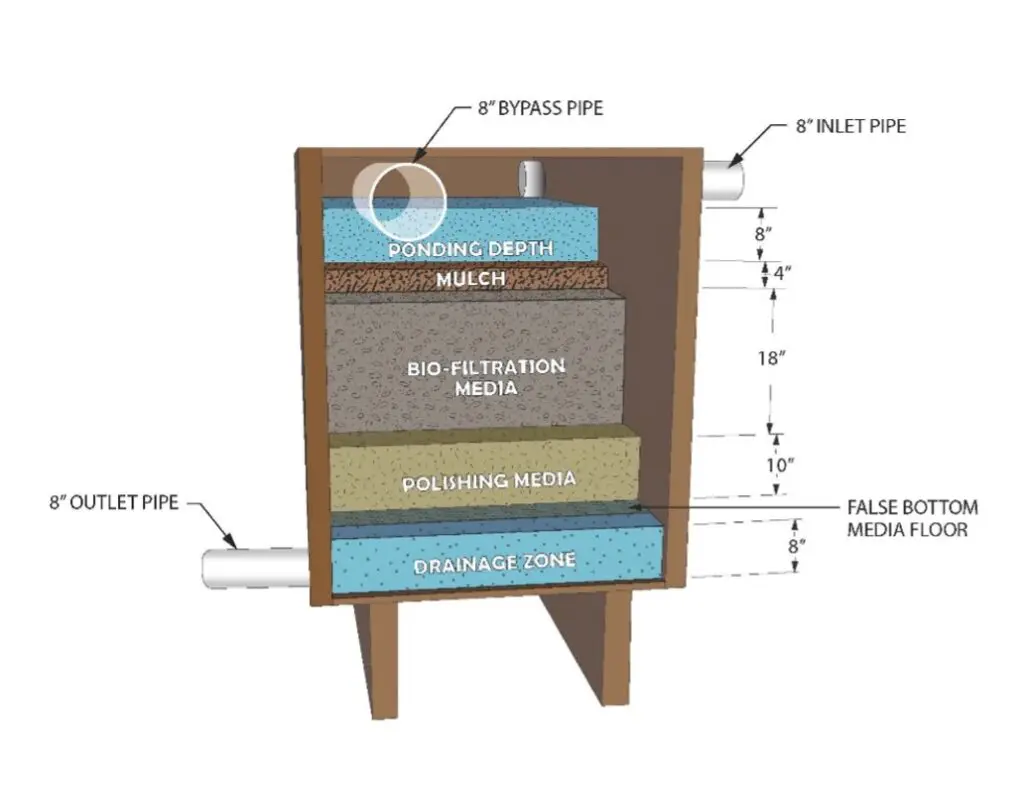Using innovative technology to protect salmon habitat
Can an innovative stormwater management practice prevent toxic roadway runoff from impacting key salmon habitat?
To both prove the effectiveness of an innovative best management practice (BMP) and protect key coho habitat along Highway 7, Long Live the Kings and our partners are expanding on previous testing of a containerized, compost-based, biofiltration system to collect and clean roadway runoff before it reaches Ohop Creek, which is a tributary of the Nisqually River.
Project Location
The project site is located within the Nisqually Watershed in Pierce County where State Route 7 (SR 7) crosses Ohop Creek on land owned by the Nisqually Land Trust. The site is located immediately off SR 7, allowing the biofiltration system to filter stormwater runoff from the elevated roadway before it enters the adjacent Ohop Creek. Ohop Creek is the third-largest tributary of the Nisqually River accessible to salmon and one of the most ecologically important spawning and rearing grounds for coho salmon in the Nisqually Watershed.
A stormwater best management practice or BMP is a method or tool used to manage stormwater runoff by controlling runoff rate, improving water quality, and managing runoff volume. Currently, the project site does not have a permanent stormwater BMP in place, resulting in roadway runoff seeping into the groundwater, and subsequently into Ohop Creek. The Nisqually Indian Tribe selected our project site with the purpose of meeting Tribal priorities around reducing toxic loads near Tribally important coho populations. For this effectiveness study, the stormwater management system was installed between two SR 7 bridge crossings so that roadway runoff from approximately 530 linear feet or roughly 13,249 square feet of roadway surface was captured and directed to the stormwater management system.
As Puget Sound’s population grows, so does the traffic along SR 7, which is the main road to and from Mount Rainier National Park.
How Key Habitat can become Lethal to Salmon
For decades across the West Coast, salmon, primarily coho, have been dying from exposure to stormwater runoff — water that washes from roads, carrying with it a wide variety of pollutants. In 2020, researchers at Washington State University Puyallup and University of Washington Tacoma determined that a chemical called 6PPD-quinone (6PPD-q) was responsible for the detrimental effects and found that it resulted from the breakdown of tire wear particles that collect on roads reacting with ozone.
6PPD-q (aka tire dust, tire wear particles, or tire wear toxics) represents a huge threat to salmonids, especially for juvenile and pre-spawn adult coho. Current traffic deposits around 12 pounds of tire dust on the road crossing Ohop Creek each year, washing approximately 121.5 ng/L, which is well higher than the LC50 of 6PPD-q for coho salmon. (An LC50 value describes the amount of a substance in water or air that is expected to kill 50% of a given species)
The table below highlights the susceptibility of Pacific salmon and steelhead to 6PPD-q, excluding chum salmon as they have demonstrated resilience to 6PPD-q in lab studies.
| Species | LC50 of 6PPD-q | Reference |
| Coho salmon (O. kisutch) | 41-95 ng/L | (Lo et al. 2023; Tian et al. 2022) |
| Steelhead (O. mykiss) | 640-2260 ng/L | (Nair et al. 2023; Di et al. 2022) |
| Pink salmon (O. gorbuscha) | >12800 ng/L | (Foldvik et al. 2024) |
| Sockeye salmon (O. nerka) | >50000 ng/L | (Greer et al. 2023) |
| Chinook salmon (O. tshawytscha) | 82100 ng/L | (Greer et al. 2023) |
*LC50 describes the amount of a substance in water that is expected to kill 50% of the species Genus abbreviation: O. (Oncorhynchus)
Identifying 6PPD-q was a critical first step to finally addressing coho mortality from roadway runoff, but there is still an urgent need for effective and adaptable solutions to treat stormwater before it reaches salmon streams. While policymakers and scientists are working with the tire industry to find safe alternatives, 6PPD-q will be present in stormwater for years to come and more research is needed to identify effective BMPs at removing 6PPD-q from the natural environment.
“This is the DDT of our generation.”
– David Troutt, Natural Resources Director, Nisqually Indian Tribe

What Long Live the Kings is Doing for Nisqually Coho
Long Live the Kings, in partnership with the Nisqually Indian Tribe, has teamed up Cedar Grove, Herrera, and other partners to expand on previous testing of a containerized, compost-based biofiltration system to collect and clean roadway runoff before it reaches Ohop Creek.
Cedar Grove designed, built, and installed the stormwater treatment system used for this effectiveness study. Long Live the Kings serves as project management. Herrera is contracted to provide technical support and stormwater sampling installation services. WSU Puyallup is contracted to lead stormwater sampling, with support from the Nisqually Indian Tribe.
By treating stormwater off SR7 during the project period, the biofiltration system will reduce 6PPD-q levels in important coho spawning habitat and downstream of the project site. Reducing or eliminating 6PPD-q and other harmful roadway contaminants from entering salmon-bearing waterbodies will help to improve ecosystem resilience and complement the Nisqually Indian Tribe’s significant and ongoing investments in habitat restoration in Ohop Creek as they work to restore Tribally important salmon populations.

Why is Long Live the Kings Using this BMP?
This stormwater BMP utilizes biofiltration, which is a method that uses living material – such as plants, mulch, and compost – to remove pollution from contaminated water. Rain gardens and bioswales are examples of biofiltration systems which capture runoff and allow it to slowly filter through vegetation and layers of mulch and soil, removing pollutants.
The Nisqually Indian Tribe and Long Live the Kings selected Cedar Grove’s innovative vehicle-impacted stormwater biofiltration container system (i.e. a containerized system using compost as a natural filtration system) because the system is modular and easier to install in ecologically sensitive areas like floodplains, where hydroperiods are rapidly changing and traditional in-ground systems cannot adapt without major construction. This was especially important for Ohop Creek given that the Nisqually Land Trust and Nisqually Indian Tribe had previously restored the riparian areas and ground disturbance associated with a traditional, in-ground solution was not feasible. Additionally, the system’s ability to capture and treat stormwater runoff from bridges and elevated roadways offers an important potential solution at other Nisqually Indian Tribe-led recovery projects such as the ongoing Nisqually River Delta Restoration Project.
In addition, by conducting this effectiveness study and preparing the system to move forward through Washington Department of Ecology’s TAPE process, the region would have another tool to mitigate for 6PPD-q, including a novel soil mix that could be used in numerous biofiltration applications. This soil mix consists of 60/40 compost-based biofiltration media and a 10-inch polishing layer consisting of sand, alumina, and iron. This combination has yet to be tested outside of this effectiveness study, but early results have been promising.


What Difference this BMP Could Make
This initial evaluation of the biofiltration system took place between 2022-23, identifying levels of 6PPD-q at the Ohop Creek project site well above the LC50 values for juvenile and adult coho salmon and demonstrating a system removal efficiency of a promising 92.5% of 6PPD-q filtered from stormwater runoff. Over the next two years, we will collect samples from 15 storm events and track the system’s effectiveness.
As Puget Sound communities work to mitigate the effects of toxic contaminants from tire wear, they need BMPs that are effective, easy to implement and maintain, and cost-efficient. If proven successful, Cedar Grove Compost’s biofiltration system could offer a valuable new BMP for the region. As a result, this system offers enormous potential to improve the receiving waters and health of Puget Sound’s waterways and communities by deploying in stormwater hotspots not suited for in-ground biofiltration, such as Puget Sound’s abundant floodplain and estuarine habitat.